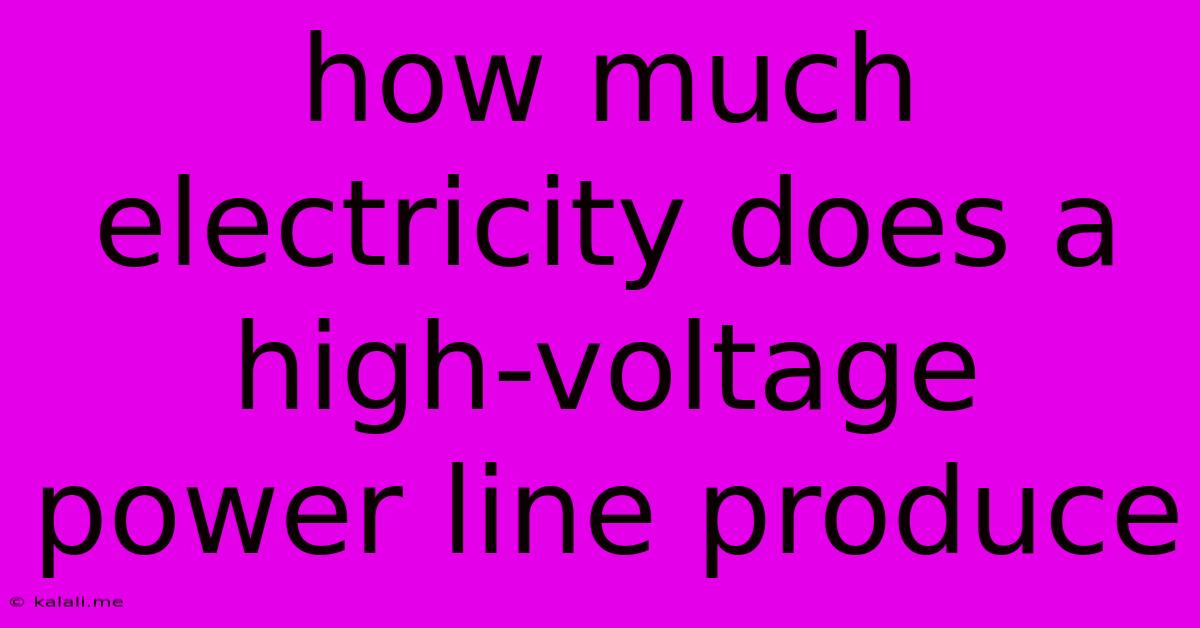How Much Electricity Does A High-voltage Power Line Produce
Kalali
May 23, 2025 · 3 min read

Table of Contents
How Much Electricity Does a High-Voltage Power Line Produce?
Meta Description: High-voltage power lines don't produce electricity; they transmit it. This article explains the difference and explores the factors influencing the amount of electricity transmitted along these lines.
High-voltage power lines are a common sight, stretching across vast distances, carrying the electricity that powers our homes and businesses. But a common misconception is that these lines produce electricity. They don't. High-voltage power lines are simply the transmission system, the highway for the electricity generated elsewhere. The actual electricity production happens in power plants, utilizing various sources like coal, natural gas, nuclear, hydro, solar, and wind.
This article will delve into the complexities of electricity transmission and clarify the role of high-voltage power lines in the process. We'll explore the factors affecting the amount of electricity transmitted and debunk some common myths.
Understanding Electricity Generation and Transmission
Electricity generation occurs in power plants where various energy sources are converted into electrical energy. This electricity is then stepped up to high voltage using transformers. This is crucial because transmitting electricity at high voltages significantly reduces energy loss over long distances. The higher the voltage, the lower the current needed to transmit the same amount of power, minimizing resistive losses (heat) in the transmission lines.
What Determines the Amount of Electricity Transmitted?
The amount of electricity a high-voltage power line transmits isn't a fixed number. It's a dynamic quantity determined by several factors:
-
Power Plant Output: The primary factor is the amount of electricity generated by the power plant connected to the transmission line. This depends on the plant's capacity and operational status. A larger power plant, operating at full capacity, will transmit more electricity.
-
Voltage Level: Higher voltage lines can transmit significantly more power than lower voltage lines, due to reduced energy losses as explained above. This is why long-distance transmission often utilizes extremely high voltages.
-
Transmission Line Capacity: Each transmission line has a maximum capacity determined by its physical characteristics – conductor size, material, and design. Exceeding this capacity can lead to overheating and potential damage. Upgrading transmission lines involves increasing their capacity to accommodate growing electricity demand.
-
Demand: The amount of electricity actually flowing through the line is also dictated by consumer demand. During peak hours, more electricity will be transmitted to meet the increased demand.
-
Line Losses: Even with high-voltage transmission, some energy is lost as heat due to resistance in the conductors. This loss is a percentage of the total power transmitted and is minimized by utilizing high voltages and proper line maintenance.
Debunking Common Myths
-
Higher voltage means more electricity produced: This is incorrect. Higher voltage means more efficient transmission, not production. The electricity is produced at the power plant, irrespective of the transmission voltage.
-
Thicker lines transmit more electricity: While thicker lines can handle more electricity and reduce losses, they don't inherently produce more. The amount of electricity transmitted is still dictated by the generation capacity and demand.
In Conclusion
High-voltage power lines don't produce electricity; they are vital components of the electricity transmission system. The amount of electricity they transmit is a variable dependent on power plant output, voltage levels, line capacity, consumer demand, and inherent line losses. Understanding these factors is crucial to appreciating the complex interplay between electricity generation, transmission, and distribution.
Latest Posts
Latest Posts
-
Steering Wheel Vibration At High Speeds
May 23, 2025
-
Matter Cannot Be Created Or Destroyed But It Can
May 23, 2025
-
What Is 104 Days From June 3rd
May 23, 2025
-
Gain More Class Feats Pathfinder 2e
May 23, 2025
-
Middle Click Rotate Not Working On 3d Builder
May 23, 2025
Related Post
Thank you for visiting our website which covers about How Much Electricity Does A High-voltage Power Line Produce . We hope the information provided has been useful to you. Feel free to contact us if you have any questions or need further assistance. See you next time and don't miss to bookmark.